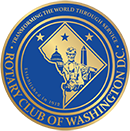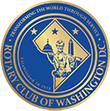Anas "Andy" Shallal | CEO and Founder Busboys and Poets | November 5, 2025
Tiffany Ervin | The CART fund | The Power of One | October 22, 2025
Elisabeth Johnson Introduces the Polio Plus Society
Patty Medina | From Salsa to Strategy: Leading with Culture, Purpose, and Heart | October 15, 2025
Linda Ryden | Teaching Children to Resolve Conflicts | October 8, 2025
H.E. Georg Sparber | Ambassador of Liechtenstein to the US | October 1, 2025
Aviva Lund | The Neuroscience of Resilience and Empathy | September 24, 2025
Jackie Reyes-Yanes | Community Affairs for Mayor Bowser & the District of Columbia | Sept. 17, 2025




